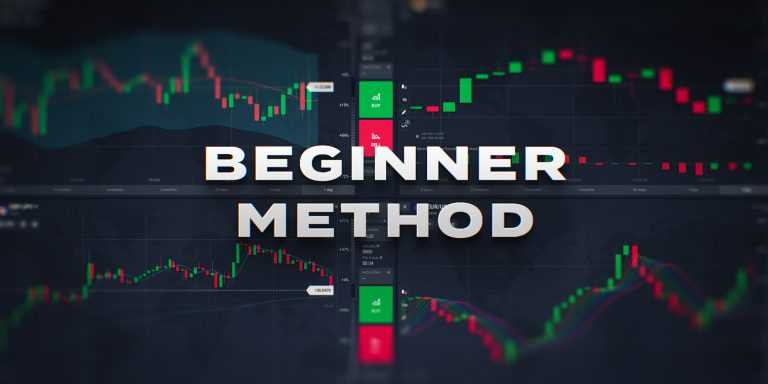Updated on January 24, 2022
If you are a novice trader, this article is for you. Trading can be extremely hard and scary but it can enhance your knowledge and experience at the same time. Analyzing markets and figuring out how it all works might be an interesting endeavor. Though there are many methods that one could try, starting with a solid and popular indicator may be a good idea.
An indicator that traders of all categories usually use is the Moving Average. The Moving Average is one of the most user-friendly indicators as it consists of just one line. This one line can provide you with a lot of valuable information if used correctly; however, always remember that there is no 100% guarantee of no errors either.
What is the Moving Average?
It is a trend indicator that consists of one line placed on the chart, above or below of the candlesticks.The main idea of the indicator is to smooth out the price noise – the price fluctuations that do not matter – and reflect the price movement ignoring the unimportant price changes. This way a trader can make a prediction about the future price changes. There are 4 types of the Moving Average, which we will review briefly.
- SMA – a Simple Moving Average that shows the average of the price for a set period of time.
- EMA is the Exponential Moving Average. It prioritizes more recent prices over older price changes, which is why this type of a Moving Average works well for short-term trading strategies.
- WMA – the Weighted Moving Average – is quite similar to EMA, as it also gives more weight to recent price changes, the only difference is in the calculation of the indicator. The WMA may alert a trader about the change in price slightly quicker than EMA.
- SSMA is the Smoothed Simple Moving Average. It takes into account a large number of candlesticks and it is much more smooth than all the other types. It is rarely used in trading as it is the least sensitive to price changes.
How to set up this indicator?
To set up a Moving Average, simply choose it in the indicator’s menu. Every indicator has settings, which a trader may leave by default or change the indicator’s period (amount of candles taken for calculation), color or type.
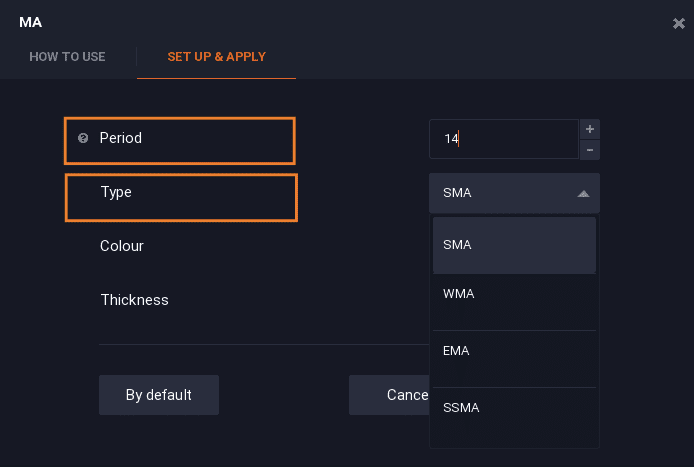
Traders may choose any type of the Moving Average, however, the most commonly used ones are the SMA and EMA.
Moving Average trading method
In order to use the Moving Average in a trading strategy, first, it is necessary to understand what this indicator can show. MA reflects the direction of the trend by following the candlestick chart and smoothing the price fluctuations for a more accurate prediction.
Using the MA indicator, traders can determine the direction of the trend and possible entry points for a deal.
In order to determine the direction of the trend, a trader may, for example, do the following:
1. Apply a Moving Average to the chart. Traders may use any of the indicator’s variations, for this example a Simple Moving Average (SMA) is used.
2. Watch for the indicator’s position in regards to the candlestick chart. When the trend is upwards, the Moving Average will be under the candlestick chart. When the trend is downwards, the indicator’s line will be above the chart. The steeper the line, the stronger the trend is.
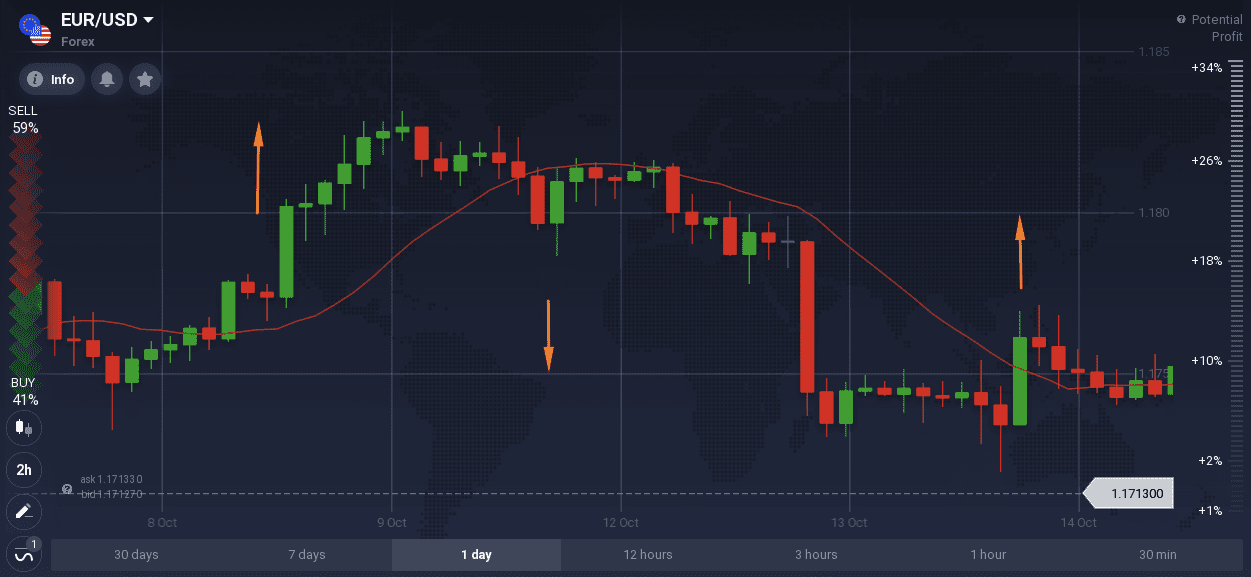
How to use this information to open a deal? What a trader needs to be looking for is the crossover – where the indicator meets the chart. Why is that? Because when the chart crosses the indicator upwards or downwards, there is a high probability of trend reversal.
Let’s look at the example below. An EMA indicator with the standard settings is used. It is applied on the EUR\USD chart with a short candle timeframe – 10 minutes.
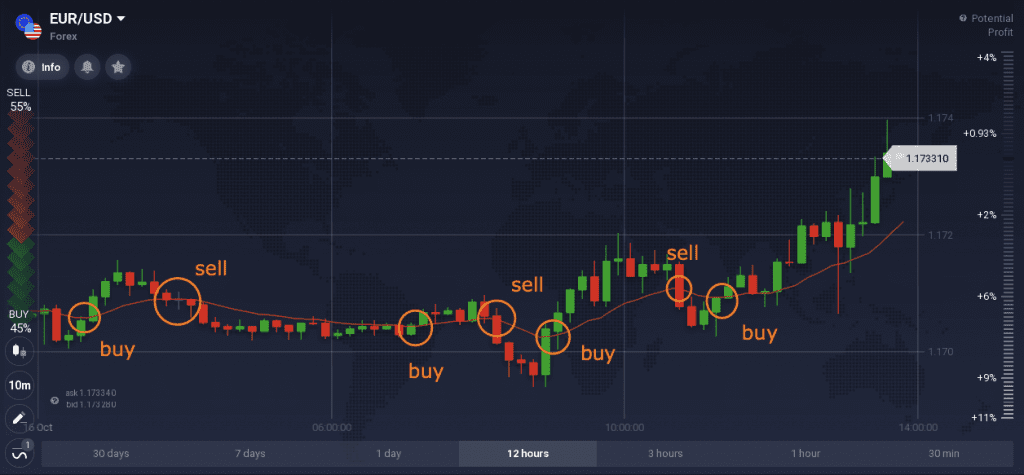
In order to find potential entry points for deals, a trader may, for instance, do the following:
1. Apply an MA indicator to the chart and watch for indicator and chart crossovers
2. When the indicator is crossing the chart from below upwards, the indicator is considered to give out a Buying signal. In such a case, a trader may consider opening a “long” position, for example, with the expectation that the price will continue to rise.
3. In case the indicator is crossing the chart from above downwards, it may be a Selling signal. A trader may consider a “short” position in this situation.
How to enhance the method?
There are ways to tailor this indicator to your particular needs. For instance, short-term traders may use an SMA with the period 8 (higher speed SMA) and combine it with an EMA of 5 period. An upwards crossover of the SMA with EMA would suggest a Buying signal, while a downward crossing would give out a Selling signal.
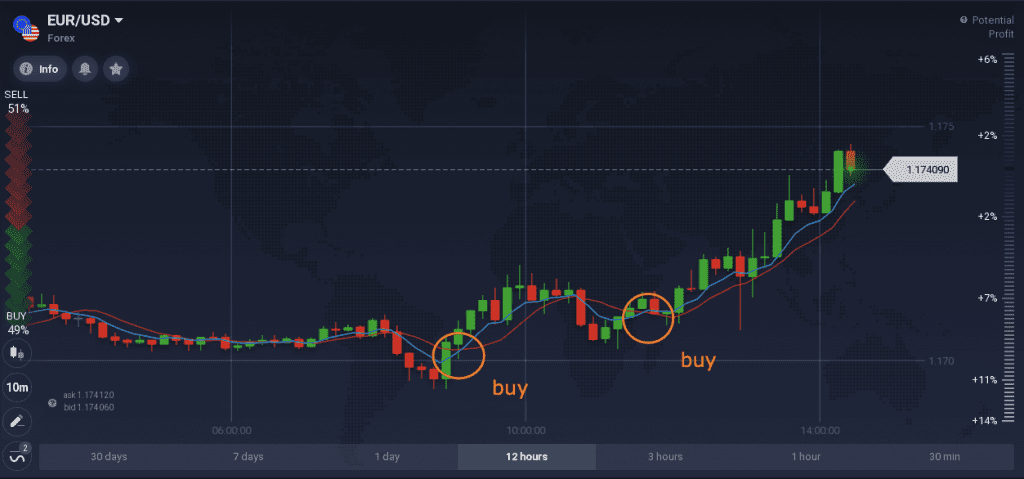
The Moving Average is a great indicator as it is uncomplicated in usage and it can be combined with many other indicators for better performance. As it is a trend indicator, it tends to fall a little bit behind the trend. Therefore, in order to increase accuracy, traders may use oscillating indicators, such as the Stochastic Oscillator or CCI.
Combining several indicators is always a better practice as it helps to confirm the received signals of each indicator and base the decision on more data. However, always keep in mind that indicators may also provide wrong signals and there is no 100% guarantee of accuracy of information.
